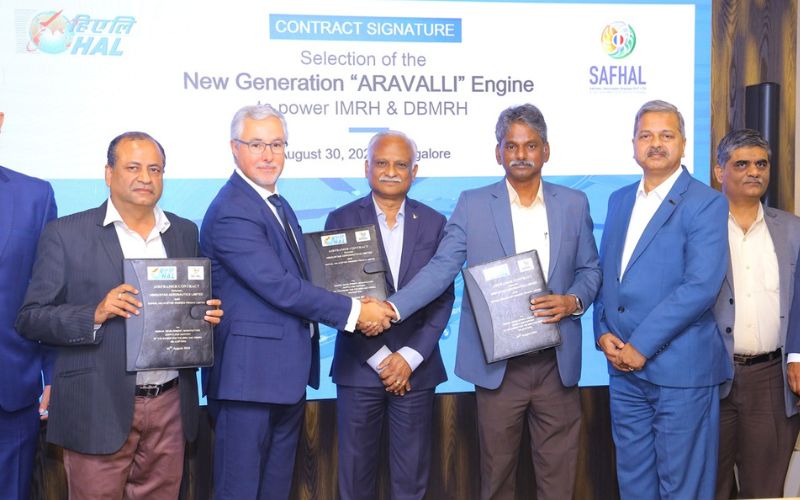“The collaboration will not only ensure the operational capabilities of the IMRH and DBMRH platforms but also contribute to the broader goal of indigenous development of critical defence technologies.” C B Ananthakrishnan, Chairman and Managing Director (Addl. Charge), HAL
“We are extremely proud to collaborate with HAL on this strategic project, capitalizing on 25 years of successful partnership between Safran and HAL. With this project, we are enriching the collaboration with HAL as well as the strategic relationship between India and France.” Cedric Goubet, CEO, Safran Helicopter Engines
Hindustan Aeronautics Limited (HAL) and SAFHAL Helicopter Engines Pvt. Ltd. (SAFHAL) have signed an airframer contract, to commence joint design, development, manufacture, supply and support of a new generation high power engine named ‘Aravalli’ for the 13-ton Medium Lift class, Indian Multi-Role Helicopter (IMRH) and the Deck-Based Multi-Role Helicopter (DBMRH), being designed & developed by HAL. The name ‘Aravalli’ derived from the mighty mountain range of India, symbolises the aspirations of the country in achieving Aatmanirbharta in critical engine technologies. The contract was signed by S Anbuvelan, CEO (Helicopter Complex), HAL and Olivier Savin, Director, SAFHAL Helicopter Engines and EVP, Sales & Marketing, Safran Helicopter Engines and S K Mehta, Director, SAFHAL Helicopter Engines and Executive Director (Finance), HAL.
C B Ananthakrishnan, Chairman and Managing Director (Addl. Charge), HAL stated, “This partnership with SAFHAL marks a pivotal moment in our journey towards achieving technological self-reliance in India’s aerospace & defence sector. The collaboration will not only ensure the operational capabilities of the IMRH and DBMRH platforms but also contribute to the broader goal of indigenous development of critical defence technologies.”
Cedric Goubet, CEO, Safran Helicopter Engines said, “We are extremely proud to collaborate with HAL on this strategic project, capitalizing on 25 years of successful partnership between Safran and HAL. With this project, we are enriching the collaboration with HAL as well as the strategic relationship between India and France. Our combined expertise and resources will ensure the success of the IMRH and DBMRH programs, while contributing to the growth of India’s aerospace & defence sector. Together we remain fully dedicated to our customers in India. We look forward to designing, producing and supporting those new efficient helicopter engines.”
SAFHAL, a joint venture between Safran Helicopter Engines SAS and HAL, is dedicated to the design, development, production, sales and support of new generation helicopter engines in India, marks a significant milestone in India’s aerospace and defence sector, aiming to enhance the nation’s Aatmanirbharta in helicopter engine technology.
Under this strategic contract, SAFHAL will work with its parent companies on cutting-edge engine technologies, ensuring superior performance, reliability, and operational efficiency. This collaboration involves state-of-the-art design, advanced manufacturing processes and rigorous testing protocols to meet the highest global standards.
IMRH is a new 13-ton multi-role helicopter designed by HAL to meet the requirements of the Indian Armed Forces. A naval version, the 12.5-ton DBMRH is also being developed for the Indian Navy. The engines will be designed to operate in diverse and challenging environments in which these Helicopters get deployed. Future extension to the civil market for offshore operations, utility, VVIP transport etc., is also planned followed by MRO activities.
Safran Helicopter Engines has been HAL’s partner of choice for powering its helicopters, starting with the Artouste engines used in Cheetah and Chetak, followed by Shakti engine and its variants powering the ALH, LCH and LUH. The present collaboration elevates this time-tested relationship to the next level through the joint design and development of modern state-of-the-art helicopter engines intended for application in Medium Lift Helicopters.

